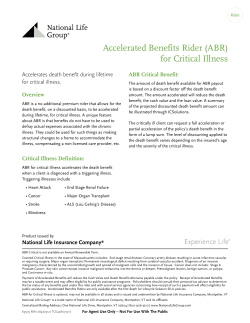
Why Should We Care About Mental Health?
Why Should We Care About Mental Health? Doug Ramsay, Health Promotion Coordinator Mental Health & Addiction Services, RQHR January 2012 Key Messages and Speaking Notes ◊ There is no health without mental health – Mental health the foundation of our physical, social, and spiritual well-being. ◊ Mental health is fundamental for the optimal well-being of individuals throughout the lifespan AND for the well-being of the entire community. ◊ Positive mental health and mental illness touch the lives of all Canadians, exerting a major effect on relationships, education, productivity and overall quality of life. 1 ◊ Approximately 20% of Canadians will experience a mental illness during their lifetime, and the remaining 80% will be affected by an illness in family members, friends or colleagues. 2 ◊ Evidence suggests that by 2030, mental health issues will be the leading cause of disability in Canada. It is estimated that the total cost of mental illness to Canadian society is approximately $192 billion (considering wider impacts such as quality of life) – the amount spent on the entire health care system in Canada. 3 ◊ On any metric, mental illness poses an enormous burden on individuals and on the wider community. Most mental health problems begin early in life and cause disability when those affected would be at their most productive (unlike most physical illnesses). The cost of mental illness accounts for more disability adjusted life years (DALY) lost than any other health condition: Mental illness – 20.0%; Cardiovascular disease 17.2%; Cancer 15.5%. 4 ◊ Costs of mental illnesses to businesses include Reduced labour productivity through • Increased absenteeism (nearly half the time off that employees take for all illnesses during the year is due to mental illness) • Increased presenteeism (employees are at work but not working productively) Resulting in • 35 million workdays lost every year (0.8% of total usual hours) • 4-12% of payroll costs for disability from mental illness 5 . Costs for disability due to depression are the fastest-growing disability costs for Canadian employers. 79% of long-term disability claims and 75% of short-term disability claims are for mental health 6 • The Centre for Mental Health in the Workplace claims that the economic cost of mental illnesses is equivalent to 20% of corporate profits 7 . Overall cost to Canadian economy: $33 billion per year (2.1% of GDP) 8 1 (Health Canada. A Report on Mental Illnesses in Canada. Ottawa, Canada 2002 © Health Canada Editorial Board Mental Illnesses in Canada) 2 (Health Canada. A Report on Mental Illnesses in Canada. Ottawa, Canada 2002 © Health Canada Editorial Board Mental Illnesses in Canada) 3 Return on Investment – Mental Health Promotion and Mental Illness Prevention. CIHI. 2011 4 Mental Health Promotion: Building an Economic Case. NIAMH. 2007 5 The Economics of Well-being. Don Drummond, SVP & Chief Economist, TD Bank Financial Groups. 2009 6 Return on Investment – Mental Health Promotion and Mental Illness Prevention. CIHI. 2011 7 Return on Investment – Mental Health Promotion and Mental Illness Prevention. CIHI. 2011 8 The Economics of Well-being. Don Drummond, SVP & Chief Economist, TD Bank. 2009 ◊ No other health condition matches mental illness in the combined extent of prevalence, persistence and breadth of impact. Yet, relative to its importance as a health problem, spending on mental health is disproportionately low. Mental health and addiction spending in Saskatchewan in 2007-08 was approximately 5% of the provincial health budget. RQHR spends approximately 4.9% of its budget on mental health and addiction services. ◊ Effective promotion and prevention have been found to reduce risk factors, strengthen protective factors, and decrease psychiatric symptoms and disabilities, and the onset of some mental disorders. ◊ Developing mental capital and improving positive mental health influences a wide range of outcomes for individuals and communities including 9 : • healthier lifestyles; • better physical health; • improved recovery from illness; • higher educational attainment; • greater productivity, employment and earnings; • better relationships with adults and with children; • more social cohesion and civic engagement; • improved quality of life; and • crime reduction. 10 ◊ The scale of the economic benefits of developing mental capital and promoting positive mental health thereby preventing mental illness is considerable 11 : • Mental health problems have very high rates of prevalence; are often of long durations (lifelong in some cases), and have adverse effects on many areas including educational performance, employment, income, personal relationships and social participation. When looking at return on investment, the scope for securing benefits by means of promotion, rather than treatment, appears to be significantly greater. Who Needs To Be Involved In Promoting Positive Mental Health? ◊ The determinants of positive mental well-being and of mental health problems are diverse and involve an interaction of genetic; biographic (age, sex); family, social, economic, environmental and cultural/societal factors. Many of the factors lie outside the health sector and involve education, social services, justice, business and the other public, private and non-profit sectors. Positive mental health is everyone’s business. ◊ Many of the determinants are malleable – we can make changes to them in order to improve their quality. There is hope! We can make a difference. ◊ Priorities for Action 12 • Social, cultural and economic conditions that support family and community life • Education that equips children to flourish both economically and emotionally • Employment opportunities and workplace pay and conditions that promote and protect mental health • Partnerships between health and other sectors to address social and economic determinants 9 Mental Health, Resilience and Inequalities. WHO 2009 Mental Health Promotion: Building an Economic Case. NIAMH, 2007 11 Mental Health Promotion: Building an Economic Case. NIAMH, 2007 12 Mental Health, Resilience and Inequalities. WHO 2009 10
© Copyright 2025





















